The excavation of the ancient tomb of a nobleman believed to be one-time emperor the Marquis of Haihun is providing China with an opportunity to showcase its latest breakthroughs in the field of conservation
Since January 15, the process of opening and preserving the inner sarcophagus of the man believed to be the Marquis of Haihun commenced in a hermetically sealed laboratory one kilometer west of the dig site in Guanxi, Jiangxi Province, where the Han Dynasty tomb was discovered. Off-limits to media and the public, the excavation process involved state-of-the-art preservation technology aimed at protecting and cataloging some 10,000 artifacts in what some are terming a “conservation ER.” Lab The artifacts removed from the tomb include tapestries, embroidery, metal containers, lacquerware and other objects of cultural and artistic significance. Most pieces are too fragile to be cleaned on-site, and thus the focus of the conservation effort is gradually shifting to the nearby lab complex.
Covering a total area of some 4,000 square meters, the Guanxi lab includes five workstations. Particularly impressive is the anoxia workstation, which utilizes aerospace technology to remove oxygen from the atmosphere and suspend vulnerable artifacts in an almostpure bubble of nitrogen with climate control technology allowing humidity to be adjusted to between 20 and 80 percent. Conservationists, armed with oxygen masks, work in a 20-square-meter glass tank pre-fitted with hermetically sealed containers for the most fragile relics, including human remains.
At another workstation, broken pieces of lacquerware still bearing black and red markings are soaked in water and kept in individual “crispers” designed to prevent their brittle outer layers from completely disintegrating. But their preservation is not guaranteed. “We are not sure yet if all these fragments can be restored and reassembled according to their original appearances,” conservationist Guan Li told our reporter.
Lacquerware is notoriously vulnerable to environmental damage, and the Guanxi pieces spent millennia submerged in an underground midden, which preserved them but could not prevent them from beginning to crumble immediately upon contact with the air. Consequently, sterile deionized water is used to keep each piece of lacquerware soaked, with restoration work focused on reinforcement, careful removal, cleaning and dechromatizing, with conservationists using infrared scanning to reveal otherwise-invisible motifs and patterns.
Each piece is then dehydrated and sealed in Plexiglas for long-term preservation.
Research work in the Guanxi lab only began in early 2016 and is expected to continue for years to come. Staff members are recording vast amounts of information from their study of the relics, including images, text, chemical and biological data, and three-dimensional models.
Experts from Beijing’s Palace Museum, an institution housed in the Forbidden City, were invited by the Jiangxi Provincial Cultural Department to participate in conservation work. “There are over 3,000 bronze or iron pieces and thousands of bamboo strips, all of which require timely modern technical protection to ensure their stability for further scientific research and analysis,” said Palace Museum curator Shan Jixiang.
According to Shan, the Palace Museum team will commence their work in Guanxi by helping to repair bronze vessels unearthed from the site (See “Grand Ambitions,” NewsChina, April, 2015, Vol. 080).
The Palace Museum is internationally renowned for its work restoring ancient bronzeware, paintings, calligraphy and other artifacts.
According to Li Cunxin, researcher at the Institute of Archeology, Chinese Academy of Social Sciences (CASS), not everything can be restored to its original appearance. During a recent interview with State newspaper People’s Daily, Li referred to the example of a rotten canopy from an excavated horse-drawn carriage. With the assistance of modern technology, he explained, archeologists can extract information and conduct a comprehensive analysis of the materials, structure and technology employed to produce an artifact in order to “make an analog restoration” and complete its “physical rehabilitation.” Archeologist Yang Jun admitted that the indoor conservation process would be “tedious” in terms of the time it would take to properly catalog and protect so many artifacts. Just restoring the lacquerware found in the tomb, he said, will take three to five years, with the final work report likely published no sooner than 2021.
“Considering the large number of artifacts from the tomb of the Marquis of Haihun, it might take one decade or two, or even the input of future generations to complete this research,” Yang told NewsChina.
Excavation While China is routinely described as a “civilizationstate” with 5,000 years of history, the country’s stringent Cultural Relics Protection Law discourages the active excavation of known important large-scale mausoleums, leaving widespread discussion of what lies within these sites largely speculative, much to the chagrin of historians both in

A jade disc edged with dragonphoenix motifs
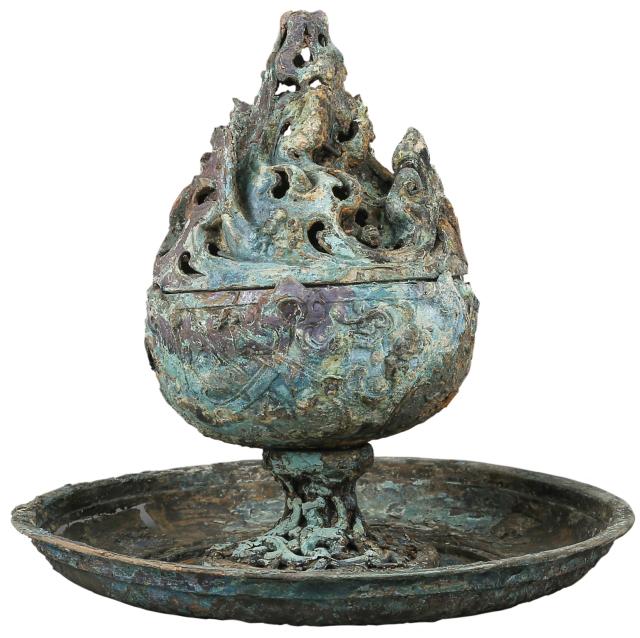
A bronze crockpot containing chestnut residue, indicating that Chinese hotpot may have been enjoyed by Han Dynasty aristocrats
China and abroad. The most famous example of this is the halting of archeological work at the main burial mound of the Qin Shihuang Mausoleum, believed to house the tomb of China’s first emperor, Qin Shihuang (See “The Warriors’ Code,” NewsChina, November, 2009, Vol. 016). Dong Mingkang, deputy director of the State Administration of Cultural Heritage (SACH), expressed publicly that the government has three main reasons underscoring its prohibition of the excavation of royal mausolea. The first obstacle is “inadequate preservation technology,” the second is an insufficient number of archeologists to meet existing demand and the third is “the need to leave some things for posterity” to allow future generations “to make discoveries of their own.” The sudden “emergency excavation” of the tomb of the Marquis of Haihun was given the green light after it was revealed that grave robbers had attempted to break into its main chamber in 2011. Yang Jun admitted to NewsChina that the tomb was not a protected cultural relic site prior to that year, and thus could not be adequately protected from thieves without assigned funding, management and institutional support. Considering the threat of looting, a common phenomenon throughout Chinese history, provincial officials gained the central government’s approval to start excavation work.
On January 6, SACH officially elevated the status of the archaeological dig at Guanxi from a provincial to a national level project, listing it, along with the excavation of the Song Dynasty (960-1279) shipwreck Nanhai I, as one of China’s most important archeological projects of that year. SACH also dispatched a national team of archeologists to offer guidance at the dig site.
To date, excavation work on one of two main burial chambers and three of seven satellite tombs has been completed.
Starting in 2014, the initial team spent almost half a year c l e a r i n g the sevenmeter- high r a m m e d earth burial mound, its layers painst a k i n g l y s t r i p p e d away “like a layer cake,” according to archeologist Tian Zhuang, with each layer photographed and mapped so that, ultimately, “we can reconstruct the building process used by our ancestors,’ Tian explained, adding that the cleared earth would be kept and used to resurface the necropolis in the future.
Li Wenhuan, a graduate student specializing in artifact conservation, emphasized the care taken to use bamboo sticks and brushes, rather than bare hands, to separate dirt from buried artifacts. Each item unearthed was scanned and photographed before being numbered in sequence, marked with their position in situ, date of excavation and the names of the excavators and conservationists.
“The geographical location will facilitate the construction of a database, and, in the future, assist the restoration of the original layout of the whole necropolis,” Li added.
Each process is laborious, with five conservationists spending a month removing corrosion from 10 tons of copper coins unearthed at the site. Chemical solvents are banned from the lab, to avoid further corrosion of grave goods.
Xu Changqing, director of the Jiangxi Provincial Institute of Cultural Relics and Archeology, told NewsChina in mid-January that, historically, only two excavation projects have led SACH to form a national archeological team. One was the 1970s excavation of the Mawangdui tombs in Changsha, Hunan Province, and the other was the 1980s excavation of the Mausoleum of the Nanyue King in Guangzhou, Guangdong Province.
Some key members of the expert team dispatched by SACH include Xin Lixiang from the National Museum of China, an expert in the history of Qin and Han dynasties; Zhang Zhongli, former team

The inner coffin, encased in a crate, is lifted from the site
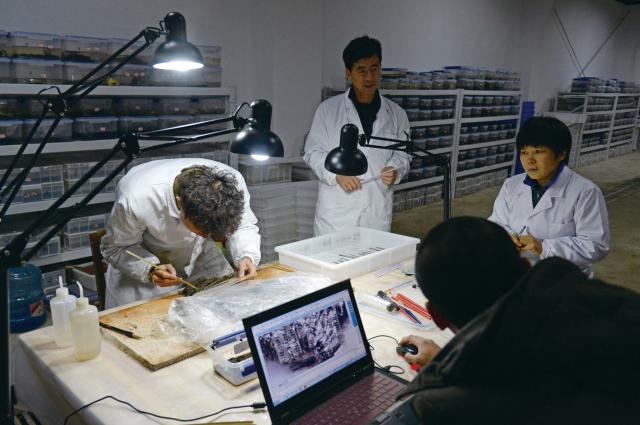
The main conservation lab
leader for the archeological team responsible for the Qin Shihuang Mausoleum; Hu Dongbo, Peking University professor and an expert in the restoration of ancient bronzes; Wang Yarong, researcher in tapestry and embroidery; and Li Cunxin, a CASS expert specializing in laboratory archeology.
Shan Jixiang described the excavation process at Guanxi as “calm and controllable,” applauding the involvement of local villagers and nationwide media coverage for raising the site’s profile. “It is highly important for the general public to enjoy the right to know, participate in, supervise and enhance the protection of the country’s cultural relics,” said Shan.
“Neither the government nor the academia should have a monopoly on the protection of cultural relics,” he continued.
“Instead, it requires the participation of people from across the country.”
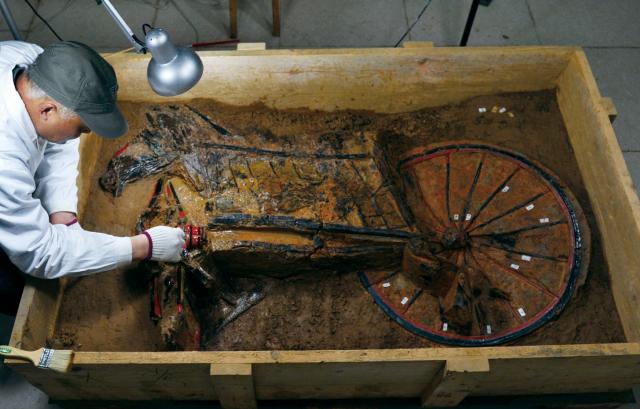
An archeologist works to preserve a mummified horse
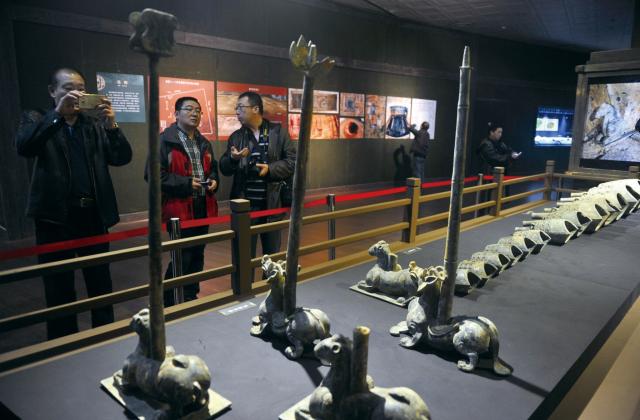
Artifacts on display in the Jiangxi Provincial Museum
Prospects In late 2015, more than 110 relics from the Haihun mausoleum went on public display at the Jiangxi Provincial Museum in Nanchang, drawing throngs of visitors.
According to some estimates, around 100,000 Han Dynasty tombs still survive in China. That era’s extravagant burial customs make those that have remained undisturbed an irreplaceable treasure trove that could revolutionize knowledge of the period. So far, 60 royal tombs from the Han Dynasty have been legally excavated for research purposes, but the tomb of the Marquis of Haihun has already eclipsed them all in terms of the number, quality and range of artifacts recovered.
Lu Xinshe, governor of Jiangxi Province, commented in a work report issued January 25 that the province will develop the area surrounding the royal tombs into a major tourist attraction. From 2016 onwards, a national archeological park will be established on the site. According to Xu Changqing, Jiangxi Province is also looking to file an application to have the tomb of the Marquis of Haihun listed as a UNESCO World Heritage Site.
Covering more than 3.6 square kilometers, the Guanxi necropolis dwarfs the 0.72-squarekilometer Forbidden City. Additional tombs belonging to scions of the marquis’ household are also believed to dot the surrounding area. “All these tombs represent a single cultural phenomenon, and no single one should be kept separate, thus the future archeological park will be a grand one and include exuberant cultural relics,” commented Shan Jixiang.
“[There], people will be able to find sources of Chinese culture and deepen their knowledge and understanding of our ancestors.”
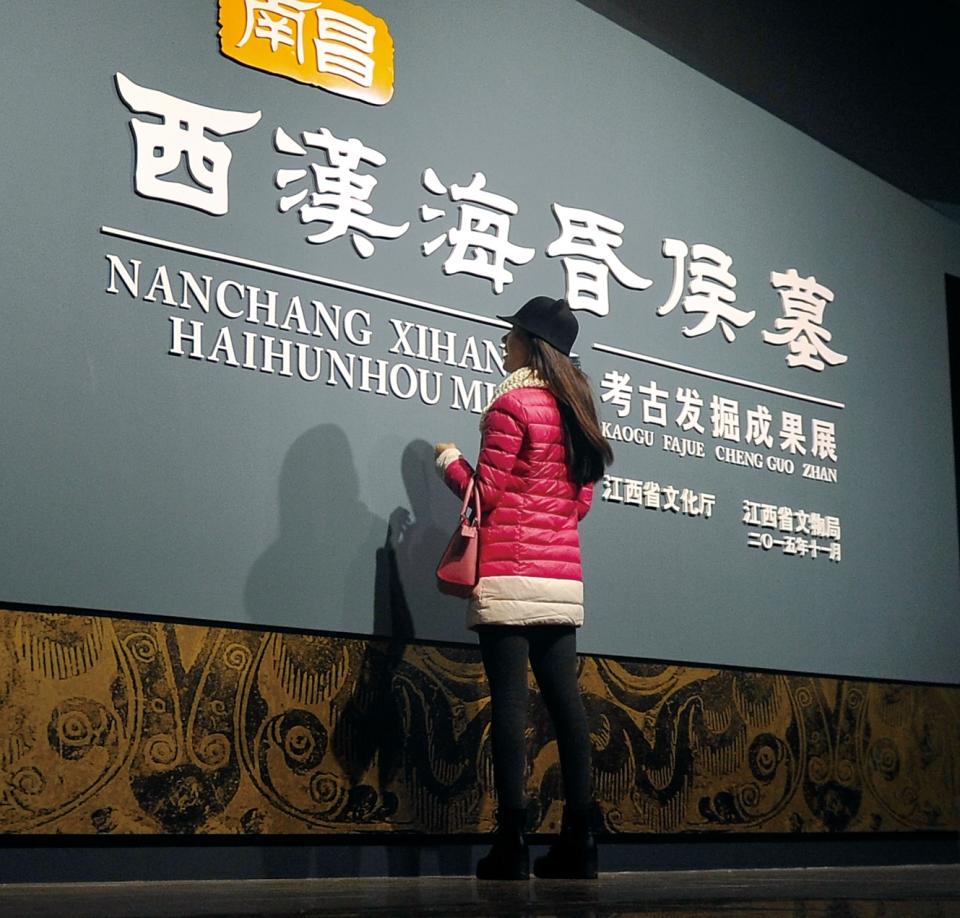
 Old Version
Old Version





